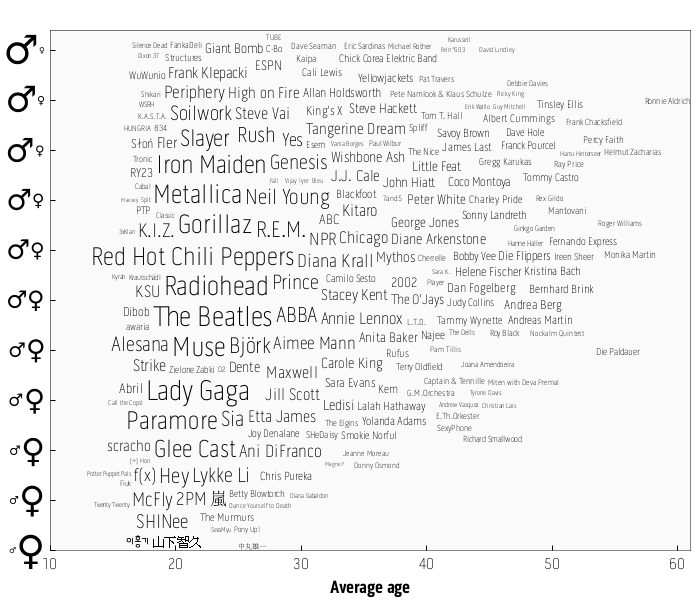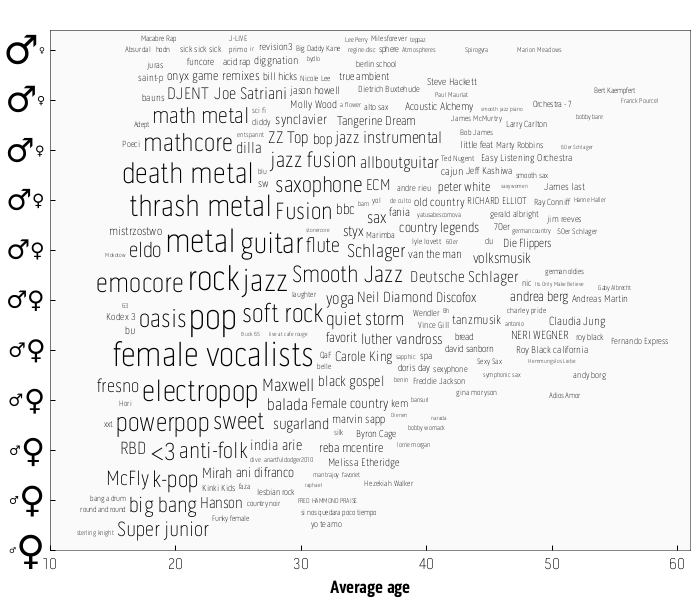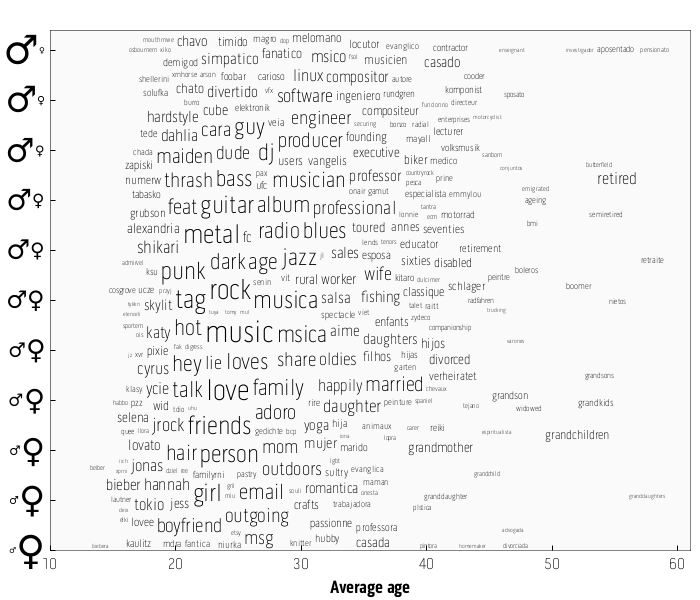Joachim Van Herwegen, an intern at Last.fm, recently decided to compile a number of plots of musical preferences based on listener ages and genders. The results are quite fascinating!
Herwegen’s first plot depicts the most common artists as a function of age (x-axis) and gender (y-axis). A quick glance will tell you that most users on last.fm are in their early twenties (text size is based on popularity), which isn’t terribly surprising. For listeners in this age group, Red Hot Chili Peppers, Radiohead, and the Beatles were extremely popular, regardless of gender. Not surprisingly, as one continues in the masculine direction, one begins to find some popular metal bands, such as Metallica, Iron Maiden, and Slayer. Continuing in the opposite direction, pop artists and bands (particularly with at least one female member), such as Lady Gaga, Paramore, and the Glee cast (from the television show Glee) become prevalent, although I was somewhat surprised by the female-bias towards the band Muse. I also noticed that NPR had a stronger male audience, which is also quite interesting. His second plot maintains the age and gender axis but instead plots tags. Among people in their early 20s, the genres of rock and jazz were almost equally liked by both genders, while metal (including an intriguing amount of “math metal”) was slightly more masculine, and “pop” and “female vocalists” were slightly more feminine. Generally, it seems that men are more likely to enjoy jazz (mostly mid-20s to mid-30s), while women are more likely to enjoy music with “spa” and “yoga” tags.
His second plot maintains the age and gender axis but instead plots tags. Among people in their early 20s, the genres of rock and jazz were almost equally liked by both genders, while metal (including an intriguing amount of “math metal”) was slightly more masculine, and “pop” and “female vocalists” were slightly more feminine. Generally, it seems that men are more likely to enjoy jazz (mostly mid-20s to mid-30s), while women are more likely to enjoy music with “spa” and “yoga” tags.
In this plot, I was actually more intrigued by some of the tags used than I was by the results, although I was somewhat concerned by a very strong male-bias towards NPR (NPR is awesome, and I feel that more people should like it). For example, what exactly is “anti-folk?” And what are tags of “sweet” and “<3” supposed to imply? The tag “Fresno”, which I personally know as a less-than-ideal city in California, also seemed to be quite popular among both genders for listeners close to the age of 15, which could explain my lack of familiarity. It’s also slightly bothersome to see such a large fan-base for Hanson, a band mostly known for this annoying song, among women in their early-20s, although I do admit that the band holds some nostalgic value for the time in my life where I actually felt like music such as that was tolerable (and maybe even borderline enjoyable).
Herwegen’s final age-gender plot describes general profile information (not only music). I was pretty amused by what appears to be a male tendency to list age and/or profession, although a tendency towards listing metal and hardcore-related items, like “dahlia” (probably referring to The Black Dahlia Murder), “maiden” (probably Iron Maiden), and “thrash” was also apparent. Women seemed to be more likely to list things relating to family, such as “married,” “divorced,” and “daughters.”
I should probably mention that all three of these plots include languages other than English, apparent in the popularity of terms such as “aime” (aimer means to like in French), musica (Spanish for music), and schlager, which (I think) means hit (as in “hit song”) in German.
Herwegen also created an application that allows Last.fm listeners to compare themselves to their friends, which can be found here (you need to log in).
If you’re interested in checking out the original blog entry from the Last.fm website, please go here.




